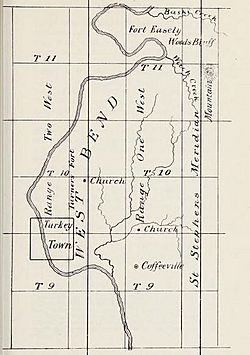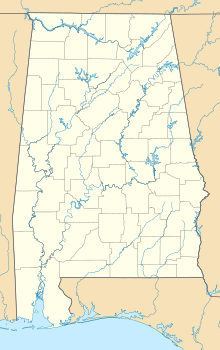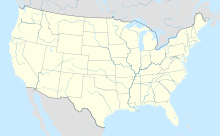Fort Easley facts for kids
Quick facts for kids Fort Easley |
|
|---|---|
| Campbell, Alabama in United States | |

Site of Fort Easley (spelled Easely) and Turkey Town
|
|
| Coordinates | 31°56′09″N 88°03′42″W / 31.93583°N 88.06167°W |
| Type | Stockade fort |
| Site information | |
| Owner | Private |
| Controlled by | Private |
| Open to the public |
No |
| Site history | |
| Built | 1813 |
| Built by | Mississippi Territory settlers |
| In use | 1813 |
| Battles/wars | Creek War |
Fort Easley was a simple fort built in 1813 in what is now Clarke County, Alabama. It was a "stockade fort," which means it was made from tall, strong wooden posts stuck upright in the ground to form a protective wall. This fort was built during the Creek War, which was a part of the bigger War of 1812.
Contents
History of Fort Easley
The Creek War and Fort Easley
Fort Easley was built in 1813 on the east side of the Tombigbee River. Its main purpose was to protect local settlers from attacks by a group of Creek warriors known as the Red Sticks. The fort covered about three acres and even had its own spring for water. It was named after an early settler in the area. The high ground where Fort Easley stood, called Woods Bluff, was named after Major Wood, who owned the land nearby and fought in the Battle of Burnt Corn.
Life and Warnings at Fort Easley
In early August 1813, before the terrible Fort Mims massacre, a large religious gathering called a "camp meeting" was held at Fort Easley. Guards were always on duty around the fort. They watched carefully to prevent any surprise attacks from Red Stick warriors.
On August 21, 1813, a Choctaw warrior named Bakers Hunter arrived at Fort Easley. He came from a nearby village called Turkey Town. Hunter brought important news: a Red Stick attack was coming. He reported that about 400 warriors were waiting just twelve miles north of Fort Easley. Their plan was to attack Fort Easley first, then move on to Fort Madison. They even hoped to get help from Choctaw warriors from Turkey Town.
A settler who lived among the Choctaw people confirmed this news to Captain Cassity, the commander of Fort Easley. This information was quickly sent to Fort Madison the next day. By August 23, the reports reached General Ferdinand Claiborne in St. Stephens.
The very next day, more than one hundred settlers left Fort Easley and arrived safely at St. Stephens. This left only about six to fifteen soldiers to defend Fort Easley. Because of these reports, General Claiborne felt it was important to send more help to Fort Easley. He personally led twenty "dragoons" (soldiers who rode horses and fought on foot) and sixty other soldiers to protect the fort.
After Claiborne decided Fort Easley was no longer in danger, he planned to return to Fort Stoddert. But on his way, he received news of the massacre at Fort Mims. He immediately changed course and headed to the military camp, or "cantonment," at Mount Vernon.
The Bashi Skirmish and the "Potato Expedition"
In early October 1813, Colonel William McGrew left St. Stephens. He had twenty-five "militia" members (citizen soldiers) with him. They were heading towards Fort Easley because of reports about Red Stick warriors in the area. Near Fort Easley, McGrew's group was ambushed by Red Sticks. Colonel McGrew and three other militia members were killed. This event became known as the Bashi Skirmish.
Soon after, General Thomas Flourney, who was in charge of the 7th Military District, ordered General Claiborne to go to the same area. Claiborne's forces included volunteers, some militia companies, and dragoons led by Lieutenant Thomas Hinds. Before they reached Fort Easley, they found the bodies of McGrew and the three militia members. Three of Hinds' men were also wounded when they were ambushed by Red Sticks.
Many of the soldiers on this trip became unhappy. One of them was Jeremiah Austill, who later became famous for his part in the Canoe Fight. The soldiers jokingly called this difficult journey the "Potato Expedition." Claiborne stayed at Fort Easley for about a month. He did not find any more Red Stick warriors during that time. After a month, he returned to St. Stephens.
Some time after General Claiborne left, Fort Easley was no longer used and was abandoned.
Fort Easley Today
Today, there are no remains of Fort Easley left at its original site. The United States Army Corps of Engineers now manages the Woods Bluff Public Access Area near where the fort once stood. A community called Woods Bluff grew up around the site. It even had a post office from 1835 to 1937.



